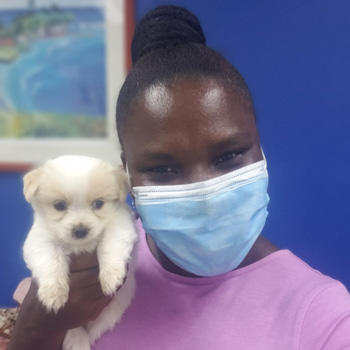There’s no question that alum Justin Boorstein, DVM (’12) loves his job. By day, he works at the Humane Society of Tampa Bay, Fla., performing surgeries on domestic animals. By night, he volunteers at the Big Cat Rescue of Tampa, doing… more surgeries and basic care on big cats.
“At first I thought I wanted to work in private practice. Now, here I am and all I’ve ever done is work for nonprofits,” says Dr. Boorstein. “And I couldn’t be happier.”
Dr. Boorstein recently came back to Ross University School of Veterinary Medicine (RUSVM) to speak to vet students in the Zoo, Exotic and Wildlife club on campus. It was an opportunity for students to learn about the basics of treating and caring for big cats, including feeding, cleaning, enrichment, common diseases and safety.
“As veterinarians, we have so many options to practice veterinary medicine,” says Dr. Boorstein. “You can do anything with a DVM degree.”
A Day in the Life
When asked what a typical day is like for him, Dr. Boorstein is quick to emphasize that there really is no “typical day,” especially as he takes on many emergency cases as needed. But in general, Dr. Boorstein treats about five or six patients a day at the Humane Society—perhaps two dental procedures, a fracture repair, a mass removal and an exploratory.
In addition, Dr. Boorstein volunteers at the Big Cat Rescue (BCR), which houses about 80 large cats, including tigers, lions, leopards and cougars. The cats come from state seizures, private possession, or failed sanctuaries, where they were usually kept in deplorable conditions. Occasionally they come from abroad. For example, one of their most recent rescues is a tiger from a circus in Peru.
“It’s like a retirement home for big cats,” says Dr. Boorstein. “It’s a hands-off facility—we don’t do any breeding, buying, selling, or playing with them. One of our main goals is to end the private ownership of large cats. There is no reason for someone to have a tiger in their backyard.” To that end, in February 2016, legislation—the Big Cat Public Safety Act of 2016—was introduced in the U.S. House of Representatives and Senate to help end the private ownership of lions, tigers, and other big cats.
Although Dr. Boorstein specializes in large felines, he’s done plenty with smaller ones as well. He gained national media attention last year as the vet who treated the “Zombie Cat,” a house cat who was found apparently lifeless after being hit by a car, buried, and subsequently discovered alive in a neighbor’s yard five days later.
“I wired his broken jaw, had to remove one of his eyes, fixed up a defect to his hard palate, placed a feeding tube, and did a blood transfusion,” says Dr. Boorstein. “He’s doing great now, although a little obese.”
“I’m Happy Every Day I Go to Work”
Even when he’s not treating cats that have clawed their way back to life, it’s safe to say that as a nonprofit veterinarian specializing in exotics, Dr. Boorstein has had a fairly atypical veterinary career. But he wouldn’t trade it for anything.
“It depends what you want out of your life,” says Dr. Boorstein. “As for me, I’m happy every day I go to work. I love being able to help people and animals that have nowhere else to go.”
For students or grads who are interested in following his footsteps, he suggests starting out by volunteering.
“There’s tons of sanctuaries and little nonprofits that need help and would love someone to donate their time,” says Dr. Boorstein. “I started out as a keeper at Big Cat Rescue before vet school. If you really want to work with them, it may turn into a job. But sometimes you just have to do it for the fun of it, too.”
For Dr. Boorstein, it sounds like he’s managed to combine work and play seamlessly in his career.
“I want to thank Ross for giving me the opportunity to become a vet and live my dream,” he says. “I couldn’t be happier with the way things turned out.”










